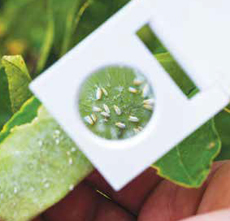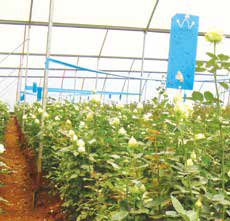
East Africa, Kenya has emerged as a prominent player in the global cut flower industry. The nation’s temperate climate, fertile soils, and skilled labour force create a favorable environment for producing a wide variety of high-quality cut flowers. In this realm of horticulture, scouting, a fundamental agricultural practice, takes center stage. This practice involves systematic monitoring of crops for pests, diseases, and other growth-related issues. In Kenya’s cut flower growing sector, scouting plays a pivotal role in ensuring product quality, maintaining profitability, and upholding sustainability.
I. The Significance of Scouting in Cut Flower Growing
Cut flower growing is a delicate balance between art and science, where care and attention are essential to produce aesthetically pleasing and healthy blooms. Scouting, is an indispensable practice that aligns with the principles of sustainable agriculture. It involves continuous monitoring of crops to detect the early signs of pests, diseases, nutrient imbalances, and other stressors that might hamper plant growth.
Scouting offers several key advantages
1. Pest and Disease Management: Pests and diseases pose significant threats to the cut flower industry. The close quarters in which flowers are cultivated make them susceptible to rapid pest outbreaks and disease transmission. Through vigilant scouting, farmers can swiftly identify the emergence of pests or diseases, allowing for timely intervention measures. This reduces the reliance on chemical pesticides, promoting environmentallyfriendly practices.
2. Quality Assurance: The quality of cut flowers significantly impacts market demand and price. Scouting enables growers to address issues that could compromise flower quality, such as malformation, discoloration, or deformities caused by pests or unfavorable growing conditions. Detecting such issues early on facilitates corrective actions, ensuring that only premium quality blooms reach the market.
3. Yield Enhancement: Optimizing yield is a core objective for any agricultural venture. Scouting assists farmers in identifying factors that could hinder optimal growth, such as nutrient deficiencies or water stress. Addressing these factors promptly contributes to increased flower production, subsequently boosting profitability.
4. Sustainability: Kenya’s cut flower indust has faced scrutiny for its environmental impact, particularly in terms of water usage and pesticide residues. Scouting promotes sustainable practices by minimizing the use of harmful chemicals and optimizing resource utilization. By identifying potential issues before they escalate, growers can adopt preventive measures that align with sustainable agriculture principles.
II. Methodologies of Scouting
Scouting in cut flower farms involves a systematic approach that encompasses various steps, from field observation to data analysis. This process is rooted in the principles of integrated pest management and tailored to the specific challenges of the region’s cut flower cultivation.
 1. Field Observations: Scouting begins with frequent and thorough field observations. Skilled scouts traverse the flower fields, carefully inspecting plants for signs of pest infestations, diseases, nutrient deficiencies, and any other stressors. These scouts are equipped with knowledge about the typical symptoms associated with various issues.
1. Field Observations: Scouting begins with frequent and thorough field observations. Skilled scouts traverse the flower fields, carefully inspecting plants for signs of pest infestations, diseases, nutrient deficiencies, and any other stressors. These scouts are equipped with knowledge about the typical symptoms associated with various issues.
2. Identification and Documentation: Accurate identification of pests, diseases, and other growth-related problems is crucial. Once an issue is identified, scouts document their findings through written notes, photographs, and even digital apps. This data forms the foundation for decision-making and strategy formulation.
3. Pest Life Cycle Understanding: Understanding the life cycles of pests and diseases is vital for effective scouting. By recognizing the vulnerable stages in their life cycles, growers can focus their interventions at the most opportune moments. This minimizes the need for constant pesticide application and reduces the risk of resistance development.
4. Data Analysis and Interpretation: The data collected by scouts is analyzed to discern patterns and trends. This step enables growers to make informed decisions about when and how to intervene. Advanced data analysis techniques, including predictive models, are increasingly being integrated into scouting practices to enhance accuracy and efficiency.
5. Integrated Interventions: Scouting doesn’t merely end with identifying problems. It extends to implementing interventions that align with IPM principles.
These interventions include cultural practices, biological control methods, and judicious use of pesticides when necessary. The goal is to achieve a harmonious balance between crop protection and environmental sustainability.
III. Challenges and Future Directions
While scouting is undeniably valuable in Kenyan cut flower growing, it’s not without its challenges. Some of the key challenges that scouts and growers face include:
1. Labour Intensity: Scouting is a labour-intensive process that requires skilled personnel. The shortage of skilled labor in the agricultural sector, coupled with the physically demanding nature of scouting, poses challenges in maintaining consistent and effective scouting practices.
2. Rapid Pest Evolution: Pests and diseases can evolve rapidly, leading to the emergence of new strains or species that are resistant to conventional control methods. This necessitates continuous research and adaptation of scouting strategies to stay ahead of evolving pest threats.
3. Data Management: Collecting and managing scouting data can be overwhelming, especially on larger flower farms. There is a growing need for digital solutions and data management tools that can streamline the process, enhance data accuracy, and facilitate real-time decisionmaking.
4. Economic Constraints: Scouting, when not integrated into a holistic pest management strategy, can incur costs in terms of labor, materials, and time. For smaller farms with limited resources, finding the balance between the benefits of scouting and its associated costs can be challenging.
5. Climate Variability: Kenya’s climate can be variable, impacting the prevalence of pests and diseases. Climate change may lead to shifts in pest populations and their activity patterns, requiring flexible scouting approaches that can adapt to changing conditions.
6. Collaboration and Knowledge Sharing: Scouting effectiveness can be enhanced through collaboration and knowledge sharing within the industry. Sharing experiences, best practices, and innovative solutions can contribute to a more robust scouting network across the Kenyan cut flower sector.
IV. Shaping the Future: Scouting as a Catalyst for Sustainable Growth. As Kenya’s cut flower industry continues to expand, scouting remains a cornerstone of its growth and sustainability. To ensure its efficacy and relevance in the future, several strategies can be employed:
1. Capacity Building: Investing in training and capacity building for scouts and farm workers is crucial
Equipping them with the knowledge and skills to identify, document, and address issues is essential for effective scouting practices.
2. Technology Integration: Embracing digital solutions, such as smartphone apps, drones, and remote sensing technologies, can revolutionize scouting. These technologies can automate data collection, enable real-time monitoring, and enhance data analysis, ultimately improving the accuracy and efficiency of scouting.
3. Research and Innovation: Continuous research into emerging pests, diseases, and management strategies is vital. Collaborations between research institutions, government agencies, and the private sector can drive innovation in scouting techniques and pest management approaches.
4. Data-Driven Decision Making: Harnessing the power of data analytics and predictive modeling can empower growers to make informed decisions. By analyzing historical data and trends, growers can anticipate pest outbreaks and proactively implement control measures.
5. Sustainable Practices: Scouting should be integrated with broader sustainability efforts in the cut flower industry. This includes adopting practices that conserve resources, reduce chemical inputs, and minimize the environmental footprint of flower cultivation.
6. Policy Support: Government policies that incentivize and promote sustainable farming practices, including scouting, can play a significant role. Tax incentives, subsidies, and regulatory frameworks that encourage IPM adoption can contribute to the sector’s long-term sustainability.
Scouting in cut flower growing is a vital practice that underpins the success of Kenya’s thriving industry. Through vigilant observation, accurate documentation, and timely interventions, scouting enables growers to safeguard crop quality, enhance yield, and promote sustainable practices. Challenges such as labor intensity, evolving pest threats, and data management complexities must be met with innovative solutions, collaborative efforts, and a commitment to knowledge sharing.
By shaping the future of scouting through technology integration, research, and sustainable practices, the Kenyan cut flower industry can continue to flourish while minimizing its ecological impact. With scouting as a catalyst, the beauty of Kenyan cut flowers can continue to grace international markets while contributing to the nation’s economic prosperity and environmental wellbeing.
